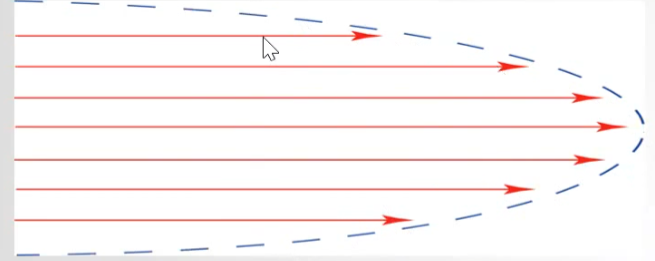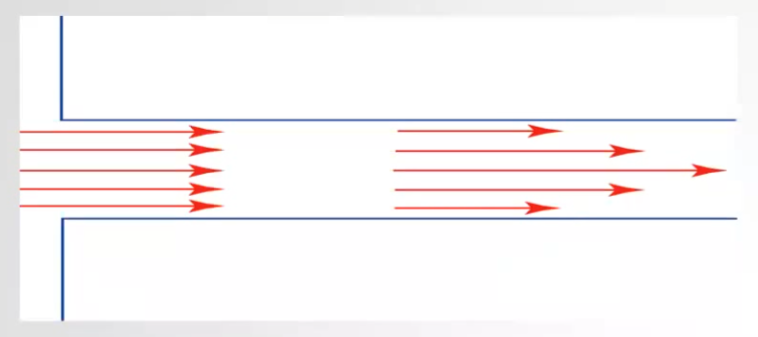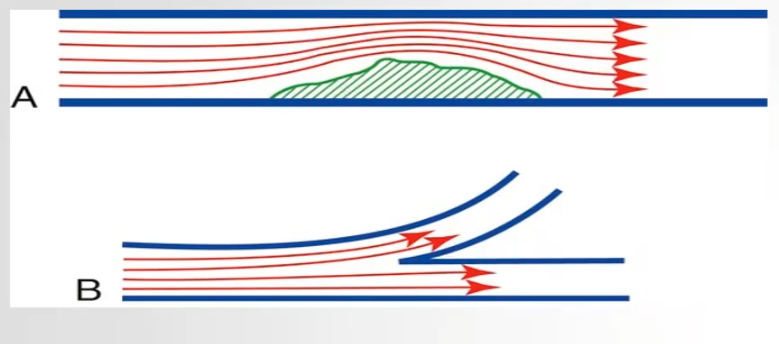Week 7 Haemodynamic Principles Lecture Notes
Haemodynamic Principles
Volumetric Flow Rate (Q)
Volume of blood passing a point per unit of time, expressed in milliliters per minute or per second.
Q is affected by:
Difference in pressure
Resistance to flow
Formula: Q = \frac{\text{Pressure difference}}{\text{Resistance to flow}}
Pressure Difference
A pressure difference is required for flow to occur.
Fluids flow from areas of higher-pressure to lower-pressure; this is also called a pressure gradient.
In the body, the heart creates the pressure difference (gradient).
The greater the difference in pressure, the greater the flow rate (Q).
Example: Pressure drops from 100 mmHg in the aorta to almost 0 mmHg in the right atrium.
Resistance to Flow
Three main factors affect resistance to blood flow in a long, straight vessel:
Viscosity of blood (\eta)
Radius (r)
Length (l)
Poiseuille’s Formula: R = \frac{8l\eta}{\pi r^4}
Fluids and Viscosity (\eta)
Viscosity: The resistance to flow in liquids due to the friction forces between the molecules.
Highly temperature dependent.
The viscosity of normal blood at 37°C is approximately 5 times that of water.
Factors affecting the viscosity of blood include:
Temperature, such as hypothermia.
Pathologies, e.g., Polycythemia, Anemia, and plasma protein changes.
Poiseuille’s Law
Assumes steady flow in long, straight tubes.
Pressure difference is directly proportional to flow rate.
Diameter is directly proportional to flow rate. (diameter increases, flow rate increases)
Length is inversely proportional to flow rate. (length increases, flow rate decreases)
Viscosity is inversely proportional to flow rate. (viscosity increases, flow rate decreases)
Poiseuille Equation:

Types of Flow
Laminar Flow - Parabolic
Parallel, forward, streamlined blood flow. (Laminar=layer in Latin)
Parabolic flow: Faster in the center and slower toward the periphery.
Boundary layer: Blood adjacent to the vessel wall has frictional interaction with the wall, thus slowing velocity.

Laminar Flow - Plug
Constant speed across the vessel.
Seen at entrance to a vessel but returns to parabolic flow.

Laminar Flow - Disturbed
Blood flow still in a uniform direction but parallel streamlines are altered from their straight lines.
Boundary layer separation.
Plaque in a vessel or bifurcation

Turbulent Flow
Disorganized blood flow.
No longer uniform direction.
Random and chaotic direction and velocity.
Usually caused by stenosis

Continuity Rule
Volumetric flow rate must be constant before, within, and distal to a stenosis.
Velocity has to increase if cross-sectional area decreases.
Volumetric flow rate is equal to the average flow speed across the vessel, multiplied by the cross-sectional area of the vessel.
Continuity Equation: Q = \overline{v} \times \text{area}
The Bernoulli Effect
A pressure decrease due to high velocity at a stenosis.
If velocity increases, pressure decreases.
This pressure decrease allows the fluid to accelerate into the stenosis and decelerate out of it.
As flow energy increases, pressure energy decreases.

Pulsatile Flow
In the heart and arterial circulation, pressure and flow velocity are constantly varied by the cardiac cycle.
Pulsatile variations increase and decrease pressure and velocity.
Vessels expand and contract with each cardiac cycle, constantly changing vessel radius.
In Summary
A pressure difference is required for flow to occur.
Poiseuille's law: The volumetric flow rate (mL/min) in a long straight tube is determined by the pressure difference (\DeltaP) and the resistance (R) to flow.
Flow can be in the forms of plug, laminar, disturbed, or turbulent.
Continuity rule: Volumetric flow rate must be constant before, within, and distal to a stenosis.
The Bernoulli Effect states that pressure is lower at an area of increased velocity.